The Uffizi unveiled today the restoration on the celebrated portrait of Dante Alighieri, a fresco painted by Andrea del Cast agno (Castagno di San Godenzo, c. 1421 - Florence, 1457) for the cycle of Illustrious Men and Women that decorated the Villa di Legnaia, just outside Florence. The work was carried out by theOpificio delle Pietre Dure (under the direction of Cecilia Frosinini, director of the Opificio’s mural paintings sector, while professionals Sara Penoni and Cristiana Todaro materially handled the restoration), with funding secured by Ms. Linda Balent of the Friends of the Uffizi Galleries association, and lasted about six months.
The portrait of Dante painted by Andrea del Castagno is one of the most famous images of the Supreme Poet, and prior to the restoration it was severely altered: the progressive deposit of sediment on the pictorial surface and the subsequent interventions and retouches had in fact darkened and weighed down the chromaticism of the work, giving it an “oil painting” appearance and partly obliterating the original, more serene and calm image. In addition, the misting of colors had also had the effect of “aging” Dante’s face, which was thus far more somber and frowning than its original appearance. The restoration therefore began with in-depth research on the fresco and a scientific analysis of its execution technique and state of preservation, conducted through non-invasive diagnostic techniques (in particular using photographic filming in the various wavelengths of the electromagnetic spectrum, scanning optical surveys with Multi-VIS-NIR instrumentation of the National Institute of Optics of the CNR, micro-invasive surveys for material diagnostics and for the characterization of the preservation cases). The result has restored in the work the typical lightness of mural painting, rediscovering a face of Dante that is luminous and animated by a hitherto unseen freshness.
Unveiled this morning in the Florentine museum, the portrait will leave the museum in a few days to reach the exhibition Dante The Vision of Art, organized in Forlì by the Fondazione Cassa dei Risparmi di Forlì together with the Galleries, which are lending about fifty works, as part of the celebrations for the eighteenth-centenary of the death of the father of the Divine Comedy (the exhibition is scheduled to open April 1, Covid permitting). At the end of the exhibition, the detached fresco will be exhibited in Castagno dAndrea, the hamlet in the Florentine municipality of San Godenzo where Andrea del Castagno was born, as well as a Dantean site, since it was here that the poet, exiled from Florence, decided to accept the Florentines’ measure against him and not to return to his city (where, in all likelihood, he would be executed), thus leaving the lands of his Tuscany forever.
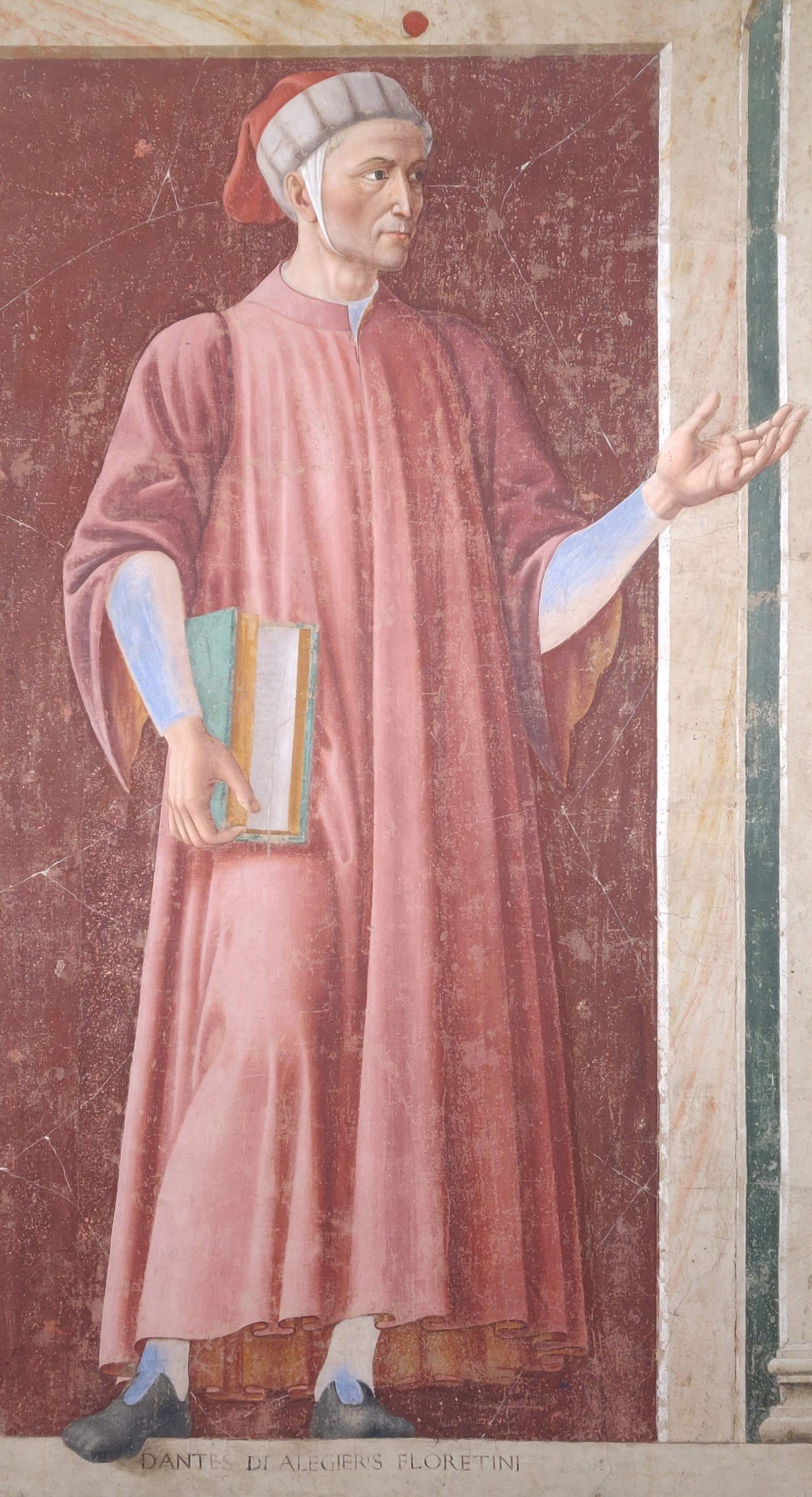 |
| Dante’s portrait after restoration |
“This is perhaps the most famous image of Dante,” says Uffizi director Eike Schmidt, “a unicona that ties in with Italian culture and spirit. It is truly splendid what you can now see: the poet looks rejuvenated and you can see precisely every hair of his one-and-a-half to two-day-old beard, something that was not visible before because of the dust and dirt of a century and a half that had collected on its surface. But there are other details that now emerge clearly, and it is also structurally strengthened, and thus ready for the trip to Forli where in a few days there will be a major exhibition with more than 300 works including more than 50 from the Uffizi Galleries. After that, for the rest of the summer, the work will instead be displayed in Castagno, then in the birthplace of the painter of this extraordinary and very famous fresco (but Castagno is also a Dantean place, so there is a double connection with this fresco: it was there that Dante and the other exiles gathered for the last time to decide whether or not to return to Florence). Significantly, the restoration was funded by Linda Balent, of the Friends of the Uffizi Galleries, the American branch of the Friends of the Uffizi. For Dante is indeed also a universal poet, and his work is relevant everywhere in the world.”
“The Opificio delle Pietre Dure, as part of its collaboration with the Uffizi Galleries,” says Marco Ciatti, superintendent of the Opificio, “has reintervened on the image of Dante by Andrea del Castagno, which represents, together with the other figures of the Villa di Legnaia cycle, an important historical restoration. For this reason, our research project focused on the current condition of the work, now restored, but it also involved an in-depth study useful for the history of the restoration.”
“It is an extremely important and interesting restoration,” commends Cecilia Frosinini, “also because, as often happens, works that seem to have almost no need for restoration then instead reveal what was hidden beneath an appearance that had become stratified and codified in everyone’s imagination. This iconic work by Dante arrived through a series of interventions and past overlays with an appearance that was much more that of an oil painting than that of a real wall painting: the possibility of removing all these added materials, these very extensive repaintings that a great restorer of the past (but with a taste, precisely, of the past), namely Leonetto Tintori, had placed on the surface, made it possible to recover different colors, much more transparent and related to the original technique, that of the fresco, where undoubtedly also the transparency of the plaster underneath gives light to the character itself. Then there has been the rediscovery of a different naturalness of the character represented: this is particularly important if we also think of a work that was very central in Florentine culture of the Renaissance, when we certainly could not think that the representation was so lowered in giving a less structured idea of Dante than the one we have. It is not an aged Dante, it is not a sullen Dante, it is not a Dante who presents himself as the fugitive Ghibellin. It is a Dante instead who reveals a maturity, but a very youthful maturity, and by the way with some elements such as for example the beard, just grown, that make us understand how they also want in a way to emphasize the humanity of this character. He is not only the great poet, the founder of Florentine cultural civilization, but also a man in his own reality. It is a bit difficult for us to understand exactly, at least in the current state of studies, what were the motivations that led to the choice of the characters to be represented in this grand pictorial cycle of Illustrious Men and Women, however, the choice to include Dante, Petrarch and Boccaccio, on a par with mythological characters and almost contemporary condottieri, must also be reviewed and reread in the light of this almost naturalistic representation. Perhaps we relive them according to the idea of the Pantheon of Florentine glories, because this was taught to us by the 19th century and their musealization that went hand in hand with the creation of the unified Italian state, which needed iconic representations that would serve as a model of a new civilization, a recreation of an Italy that was no longer a geographical expression, but that was becoming a nation. In the mid-15th century, however, this spirit was not there, this need was not there: bringing the work back to a youthful maturity means studying it again, interpreting and understanding it also in light of what the historical moment of the period was.”
“This painting,” Sara Penoni explains, “has been detached, that is, separated from its original context and has undergone numerous interventions over the centuries that have also transformed the original material, conveying a different idea: the painting actually looked like a tempera painting. Our intervention, thanks to the cleaning, has rediscovered the brightness and characteristics of the original material, and particularly in the face of the Dante has recovered the freshness and softening of the features, giving us an image of a younger Dante.”
“Observing a work up close in its technical peculiarities as well as in its fragilities,” adds Cristiana Todaro, “allows us to gather a lot of useful information to reconstruct the work’s execution process, as well as the events that have occurred over time. All these data that we were able to collect allowed us to imprint a functional restoration intervention to return to the community and public enjoyment a work as consistent as possible with its nature.”
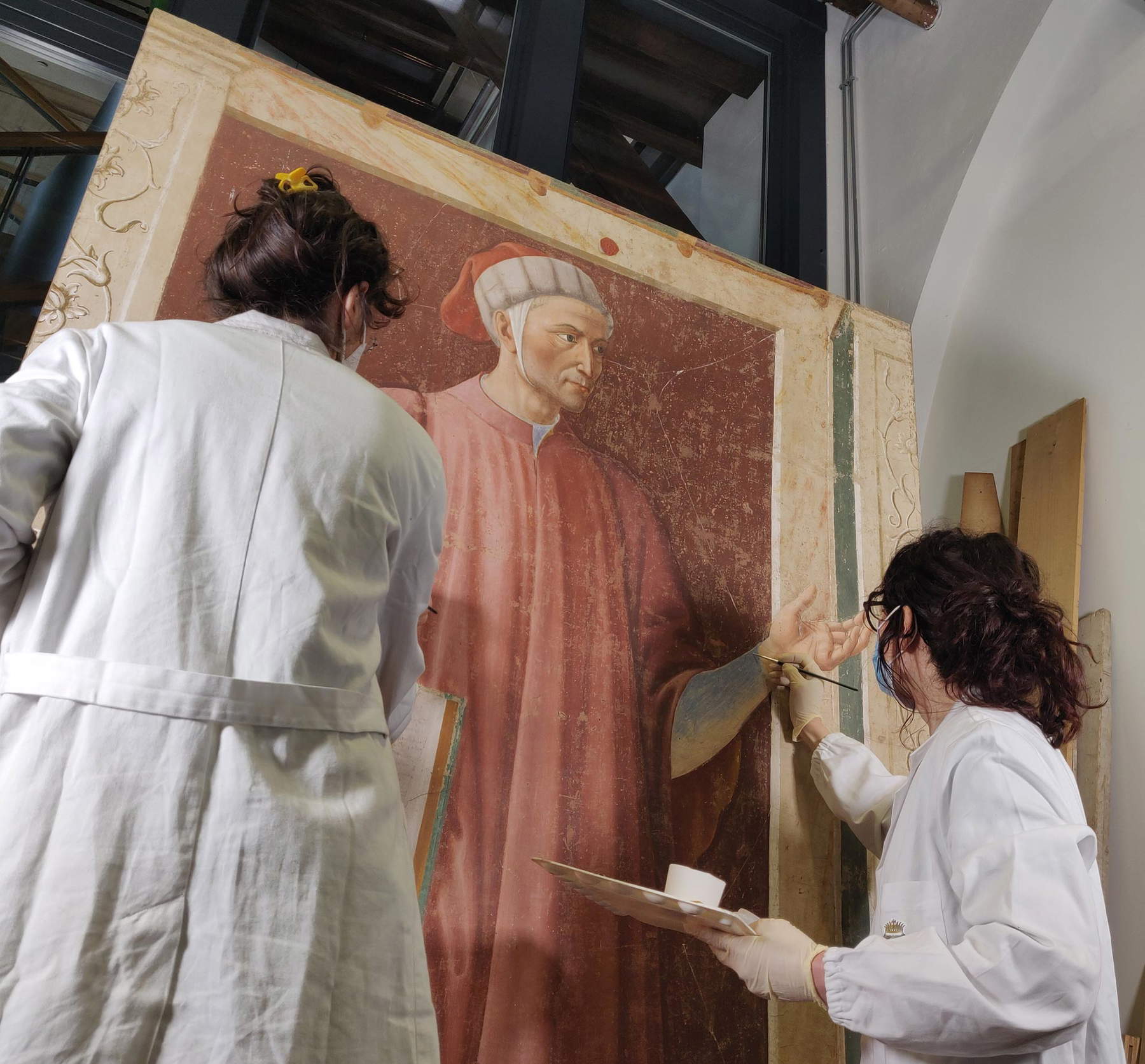 |
| The restoration |
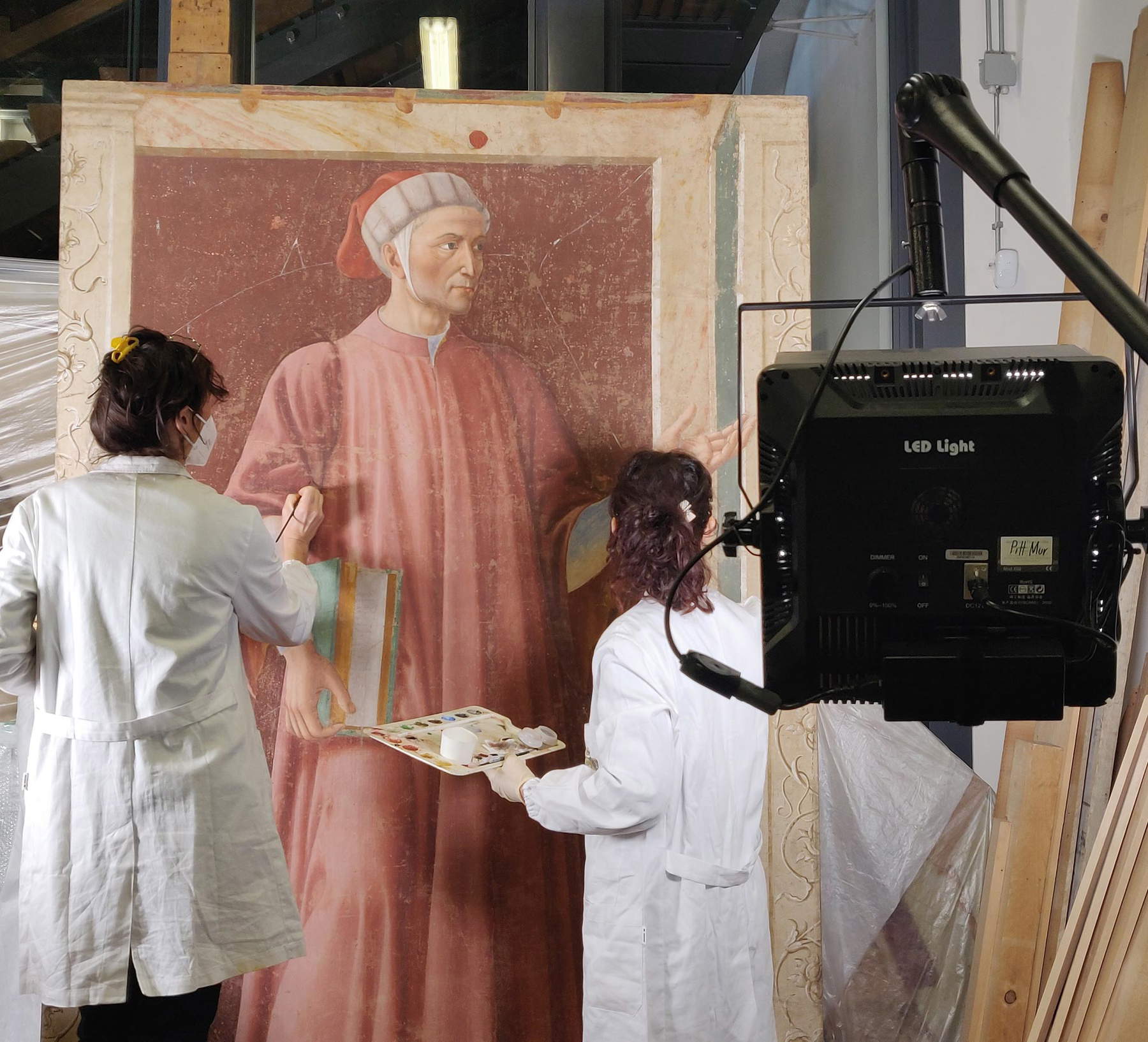 |
| The restoration |
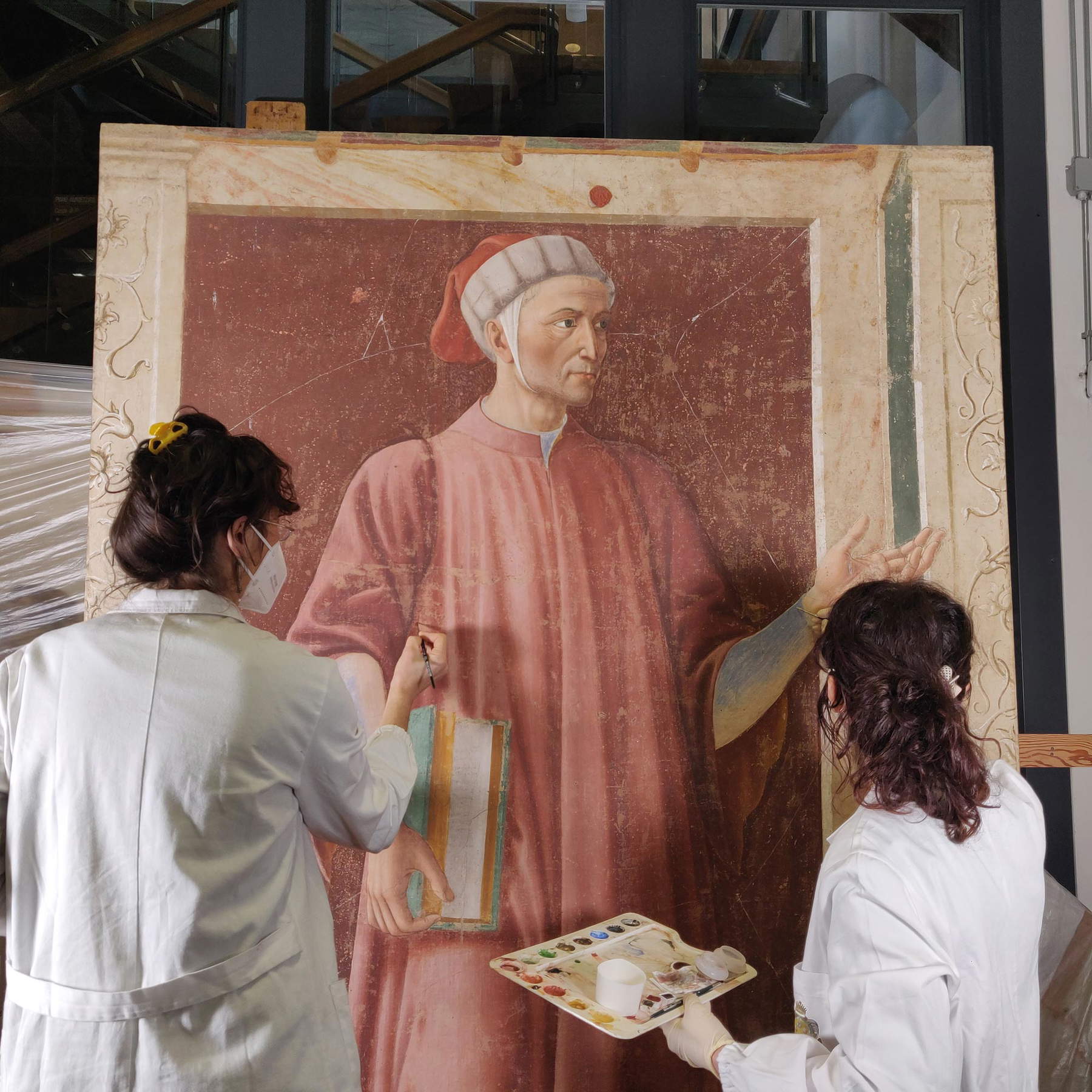 |
| The restoration |
The work was painted between 1447 and 1449 as part of the cycle of Illustrious Men and Women that Andrea del Castagno had painted in the suburban villa of Legnaia, now on the outskirts of Florence. The protagonists of the cycle included three condottieri (Pippo Spano, Farinata degli Uberti, and Niccolò Acciaioli), three wise women (Queen Esther, Queen Tomir, and the Cumaean Sibyl), and finally the triad of poets (Dante, Petrarch, and Boccaccio). Also, still in situ, Adam and Eve can be seen on one wall next to the Madonna and Child under a canopy. The presence of Adam and Eve is justified by the fact that, as already in Boccaccio’s De mulieribus claribus, the concept of illustrious men and women ultimately derived precisely from original sin, which forced human beings to earn honor and salvation through labor. This was a decoration that had distinguished precedents related to the celebration of civic virtues through the deeds of exemplary characters, here recounted in an all-Florentine declension, namely excellence in letters as a fundamental element of civic dignity and greatness.
Limportance of Andrea del Castagno’s cycle, in addition to the very high quality of the pictorial enterprise, is due to the fact that it is the only type that has come down to us commissioned for a private residence: the Villa, known as the “Carducci Pandolfini,” had belonged to Filippo Carducci (the commissioner of the cycle), who had held important public offices in Florence, including that of Gonfaloniere di Giustizia. The artist had constructed a highly illusionistic space: the figures were set in painted architecture, within classical rectangular niches, covered with porphyry and various marbles. The niches were punctuated by Corinthian pilasters supporting an entablature (partially still extant) surmounted by an attic with putti, garlands, and coats of arms. The pilasters, capitals, and architrave are ornamented with stylized thistles, in reference to the name Carducci.
The cycle fate of Andrea del Castagno’s Illustrious Men and Women was closely linked to the historical events of the Villa Carducci Pandolfini. In fact, probably due to a change of use of the rooms, at an unspecified time the frescoes were covered by whitewash. Of them, unfortunately, memory was lost for a long time, until their rediscovery around 1847, coinciding with the re-edition of Giorgio Vasari’s Lives. In 1850, when the Villa was owned by Margherita Rinuccini and her husband Giorgio Teodoro Trivulzio, the paintings were detached from the wall support with a tear-off operation performed by the Emilian extractor Giovanni Rizzoli and destined for sale. Fortunately, in 1852 they were purchased by the Uffizi: at the time, the United Italy project had rekindled the cult of the majors and placed Andrea del Castagno’s figures in an ideal dialogue with the statues placed between 1835 and 1856 in the niches of Vasari’s loggia, depicting illustrious Tuscans. In 1966 the detached frescoes were placed in the rooms of the former church of San Pier Scheraggio (the place where, in about the year 1300, Dante himself spoke as a city councilor) after a stint at the Bargello and Santa Apollonia, next to the Last Supper by Andrea himself. Today the former church is part of the Uffizi itinerary.
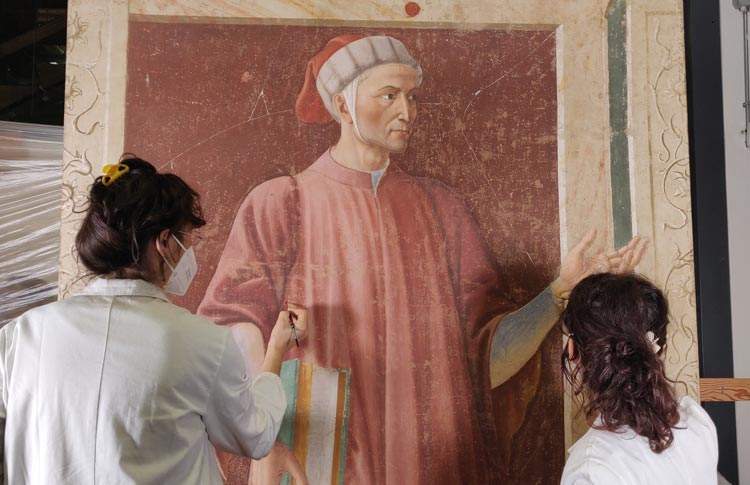 |
| Uffizi restored the famous portrait of Dante painted by Andrea del Castagno |
Warning: the translation into English of the original Italian article was created using automatic tools. We undertake to review all articles, but we do not guarantee the total absence of inaccuracies in the translation due to the program. You can find the original by clicking on the ITA button. If you find any mistake,please contact us.